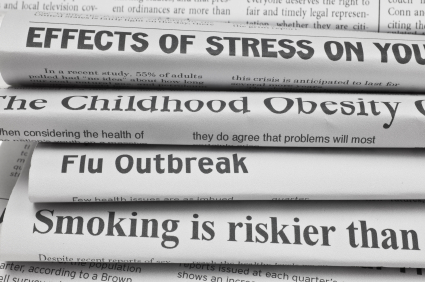Health and Science

Health Journalism Exhibits Both Improvement and Decline in Quality
Faced with dwindling resources, and a news cycle that never sleeps, today’s health journalists must meet a new challenge: provide complete, trustworthy content on health care issues with precision at the same breakneck speed with which the medical field innovates.
In an article published this year in the journal Health Communication, University of Florida College of Journalism and Communications researchers Kim Walsh-Childers, professor in the Department of Journalism, Jennifer Braddock, adjunct professor in Mass Communications, Cristina Rabaza, B.S. Medicine 2017, and Gary Schwitzer of the University of Minnesota set out to evaluate whether major news organizations have gotten better or worse at reporting on consumer health topics. This includes stories on treatments and tests, dietary changes and prescription drugs.
The researchers noted previous research that illustrates the modern reality for health journalism and its consumers. Though staffing cuts at news organizations can mean less experienced health journalists are asking fewer questions about benefits, costs and potential risks associated with medical interventions, the public still turns to news organizations for vital health information. These organizations not only affect the public’s knowledge of health issues, but their attitudes and behaviors toward medical tests, treatments, and diet.
“Given that some experts estimate that as much as 30 percent of all U.S. health care expenditures constitute overtreatment— the use of medical tests, products and services that are not medically beneficial to the patient— it is essential that news coverage provides accurate information about benefits, harms and costs of medical tests and treatments, as well as alternatives that might reduce or eliminate the need for treatment,” the researchers said in the study.
Usingthe award-winning website HealthNewsReview.org, the researchers assessed the completeness and usefulness of health coverage across 10 criteria for quality reporting, including “Does the story commit disease-mongering? Does the story compare the new approach with existing alternatives? and Does the story appear to rely solely or largely on a news release?”
The researchers studied nearly 2,000 of the site’s reviews between 2005 and 2013, and they found an evolution over time: on average, the stories reviewed between 2005 and 2010 met less than half the criteria but, by 2010 to 2013, the average story met nearly 70 percent of the criteria for quality reporting. They also found significant improvements over time in the quality of news stories related to diets, drugs, devices, surgery and other medical procedures. But they also found a decline in news stories that established the true novelty of a medical intervention, as well as no improvement over time in a news story’s ability to quantify the possible harms of a medical intervention.
The research team noted the progress made in some areas but stressed the need for even more improvement.
“It’s worth recognizing that improvements in meeting the criteria came during a period of enormous turmoil for news organizations, including dramatic declines in the number of dedicated health reporters,” they said. “Consumers now, more than ever, need to be able to rely on journalists for independent, balanced and complete information to use in making health decisions.”
In order to achieve that progress, the research team recommends increased training for health journalists to learn an “evidence-based approach to news” as well as a rise in the quality of press releases issued by medical journals and academic research centers. Though they note the importance of the researcher in communicating about medicine, the onus remains on the journalist to share this information with the public.
“Journalists must take primary responsibility for ensuring that they ask the right questions and apply critical thinking to the claims made about any sort of medical intervention,” they said.
Posted: March 28, 2018
Tagged as: Cristina Rabaza, Gary Schwitzer, health communication, health journalism, Jennifer Braddock, Journalism, Kim Walsh-Childers, UF Research


